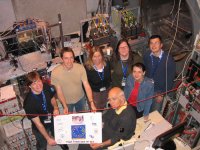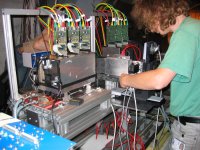 |
 |
|||||||||||||
|
|||||||||||||
|
|||||||||||||
|
The EUDET telescope, a high-precision device that lets detector developers check the accuracy of their prototype by using particle beams and the EUDET telescope and comparing with accurately its determined tracks, has just finished a marathon in test beams around Europe. During six weeks in beams at DESY and CERN its makers tested it to the core and are now happy to pass their instrument on to users.
The main objective of test beam marathon was to test the telescope under different conditions and commission the full telescope with two arms and all hardware pieces connected, checking its resolution at the same time. It even carried its very first user, the DEPFET pixel chip, an important step to see how the mechanics work, how the DAQ system behaves and how the telescope deals with a user 'in its arms'. In the ten days at CERN alone the telescope recorded a million tracks and proved that its resolution matches the designated resolution of three microns. The data analysis is in full swing, but the telescope team concludes from the first results that data taking was smooth and stable. “The instrument and the rest of the DAQ system worked almost 'out of the box',” said Antonio Bulgheroni from INFN in a talk during the EUDET meeting in Paris last week. During the combined test beams with 6-GeV electrons at DESY and 180-GeV-pions at CERN the team collected more than one Terabyte of data, accessible on the Grid for everybody to analyse. Results will be presented at the Nuclear Science Symposium (NSS) in Hawaii at the end of the month. In the meantime the SiLC (Silicon for the Linear Collider) collaboration will use the telescope to examine the quality of their silicon strip detector in the beam at CERN with the help of the telescope. “So far we have two users for 2008 and would be very happy to accommodate more,” says Ingrid-Maria Gregor, responsible for the EUDET 'Joint Research Activity 1' at DESY. R&D efforts for tracking detectors will find it especially useful. Users-to-be can apply via the EUDET website. Anyone is welcome. If the team has some connection to Europe or projects funded by the European Commission's Sixth Framework Programme they can even apply for travel support in the 'Transnational Access' scheme, an FP6-programme to support research teams in getting access to major research facilities that they need for their work. EUDET itself is a Europe-funded project with the aim to make research infrastructures available for scientists working on detector R&D. Most of these infrastructures are too expensive for a single lab and sophisticated 'calibration' tools like the telescope are a truly pan-European effort, so the project bundles and provides all things single labs cannot. The first users are happy with the experience. The DEPFET (DEPleted Field Effect Transistor) sensor is a silicon pixel sensor with a first amplification stage integrated in each pixel cell, which give it an excellent signal-to-noise ratio and likely technology for an ILC vertex detector. “In the last years the DEPFET collaboration has developed a well working prototype for this purpose. Therefore it was a quite natural step to use an ILC-oriented telescope and analysis framework to test the prototype system we have developed for the ILC vertex detector,” explains Lars Reuen from Bonn University in Germany. “We are happy about the cooperation with the EUDET group. As first user we somehow served as guinea pig gathering valuable experience for future users of the EUDET telescope and we had to run blindly during this very first test beam. But initial results show that we were running synchronized and aligned with the EUDET telescope.” -- Barbara Warmbein |
|||||||||||||
| © International Linear Collider |

